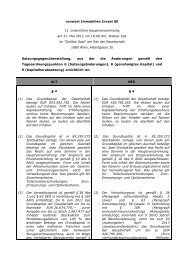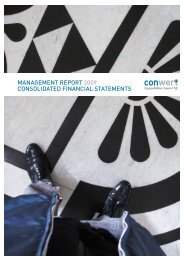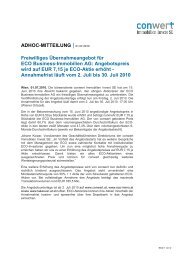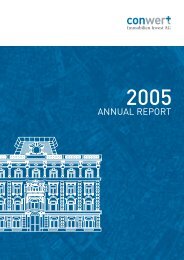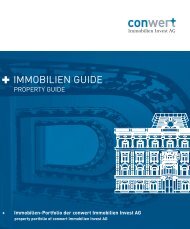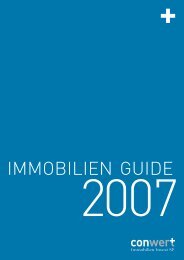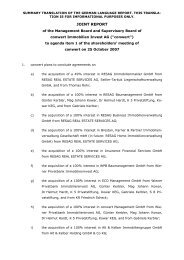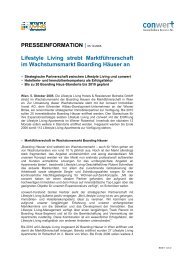annual financial statement 2011 - conwert Immobilien Invest SE
annual financial statement 2011 - conwert Immobilien Invest SE
annual financial statement 2011 - conwert Immobilien Invest SE
You also want an ePaper? Increase the reach of your titles
YUMPU automatically turns print PDFs into web optimized ePapers that Google loves.
INTRO | MANAGEMENT REPORT |<br />
| FINANCIAL STATEMENTS<br />
CONSOLIDATED FINANCIAL STATEMENTS<br />
Notes<br />
2.4.8.2. FINANCIAL LIABILITIES<br />
INITIAL RECOGNITION<br />
Financial liabilities are initially recognised at fair value plus transaction costs. The costs for the<br />
procurement of <strong>financial</strong> liabilities are netted out with the relevant <strong>financial</strong> liability.<br />
Current <strong>financial</strong> liabilities comprise current loans and borrowings, trade accounts payable and<br />
other current <strong>financial</strong> liabilities.<br />
Non-current <strong>financial</strong> liabilities comprise non-current loans and borrowings, convertible bonds,<br />
financing contributions from tenants and other non-current <strong>financial</strong> liabilities.<br />
Additional information is provided under note 8.10.<br />
FINANCING CONTRIBUTIONS FROM TENANTS<br />
The financing contributions from tenants that are shown on the consolidated balance sheet are<br />
attributable to subsidised new residential construction. These payments must be refunded to the<br />
tenants when a lease is terminated, but the landlord has a right to receive a financing contribution<br />
from the new tenant when the object is let again, and the amounts are therefore recorded as noncurrent<br />
liabilities. The initial recognition of financing contributions from tenants reflects the actual<br />
amount received, while subsequent measurement includes index adjustments. The resulting<br />
amount represents the repayment amount of the obligation, which reflects fair value.<br />
SUB<strong>SE</strong>QUENT MEASUREMENT<br />
Subsequent measurement is based on amortised cost and includes the application of the effective<br />
interest rate method. The costs for the procurement of funds are released over the term of the<br />
financing and reported under <strong>financial</strong> results.<br />
DERECOGNITION OF FINANCIAL LIABILITIES<br />
A <strong>financial</strong> liability is derecognised when the underlying obligation is discharged, cancelled or<br />
expired.<br />
2.4.8.3. DERIVATIVE FINANCIAL INSTRUMENTS AND HEDGE ACCOUNTING<br />
INITIAL RECOGNITION<br />
Derivative <strong>financial</strong> instruments are used to minimise the risks associated with changes in interest<br />
rates. All derivative transactions are concluded with <strong>financial</strong> institutions that have first-class credit<br />
ratings. These <strong>financial</strong> instruments are initially recognised at market value and reported separately<br />
under other <strong>financial</strong> assets or other <strong>financial</strong> liabilities in accordance with their market<br />
valuation. Derivative <strong>financial</strong> instruments are classified as current or non-current based on the<br />
underlying contractual cash flows. Derivative <strong>financial</strong> instruments that were designated as hedges<br />
and are considered to be effective are classified in accordance with the underlying transaction.<br />
63



